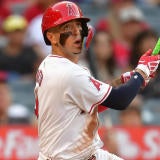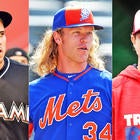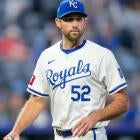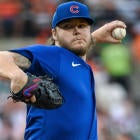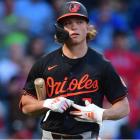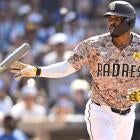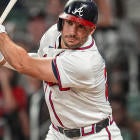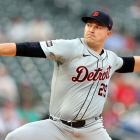You don't need any fancy numbers to tell you that Noah Syndergaard is overwhelmingly dominant. He is third in the majors in ERA, and just on a visceral level seems to overpower batters in a way few pitchers in recent memory have. We're talking Randy Johnson-level domination.
But, of course, we do have fancy numbers to tell us how overwhelmingly dominant Syndergaard has been. He is second in baseball in FIP, and actually narrowly leads Clayton Kershaw in its cousin, xFIP. He is also striking out 32.9 percent of opposing batters while walking just 3.7 percent, close to a 10-to-1 ratio (that Kershaw somehow nonetheless tops).
However, the best example of Syndergaard's visceral ability to overpower batters is probably his swinging strike rate. Despite pounding the strike zone 49.6 percent of the time (an above average rate), Syndergaard sports a 14.6 percent swinging strike rate. Opposing hitters just can't catch up.
And we can get even deeper than that by looking at individual pitch types. Syndergaard's slider is the best pitch in baseball in whiff rate, at 33.2 percent; his four-seam fastball rate of 12.6 percent ranks 10th. The 23.6 percent rate with his changeup ranks eighth, and his curveball (16.2 percent) and sinker (6.4 percent) both come in above the 70th percentile for both pitch type. Basically, whatever pitch Syndergaard is going to throw out there is more likely to garner a swinging strike than nearly any other pitcher.
That is one way to put Syndergaard's dominance in context. Let's look at where the rest of the league stacks up in swinging strike rate for every pitch type:
*All stats active through June 6 games; minimum 100 pitches
Four-seam fastball
Highest Whiff% (7.9% average)
| Rank | Player | Pitches | Velo | Whiffs | Whiff% |
| 1 | Tim Adleman | 108 | 91.9 | 19 | 17.6% |
| 2 | Rick Porcello | 182 | 92.7 | 27 | 14.8% |
| 3 | Rich Hill | 518 | 91.5 | 73 | 14.1% |
| 4 | Max Scherzer | 677 | 95.2 | 93 | 13.7% |
| 5 | Vincent Velasquez | 633 | 95.0 | 85 | 13.4% |
| 6 | Jimmy Nelson | 218 | 94.2 | 29 | 13.3% |
| 7 | Jose Berrios | 130 | 94.5 | 17 | 13.1% |
| 8 | David Price | 245 | 93.4 | 32 | 13.1% |
| 9 | Justin Verlander | 759 | 93.6 | 99 | 13.0% |
| 10 | Noah Syndergaard | 270 | 99.3 | 34 | 12.6% |
- Tim Adleman? Well, this isn't a great start!
- Porcello's place here is interesting, because part of what has made him a more interesting pitcher going back to last season was an increase in his rate of called strikes, not swinging. However, his curveball and changeup both rank as below-average pitches by this measure, and his sinker has a paltry 3.4 percent whiff rate. That explains why his swinging strike rate is down overall.
- This is one reason to still have faith in Berrios, whenever he gets another chance in the Twins rotation. The stuff was solid, he just needs to learn to control it.
- Velasquez's fastball is a real weapon, and this backs that up. The problem is, the rest of his stuff is pretty middling. His overall swinging strike rate is pretty solid, but none of his other pitches has yet developed into a true put-away pitch.
- We'll see a lot more of Syndergaard moving forward. This guy is totally ridiculous. He ranks in the top-10 in whiff rate for his slider and changeup as well, while his curveball is 16th and his sinker is still top-30. Velocity isn't everything, but it's a big reason Syndergaard is so dominant.
Lowest Whiff%
| Rank | Player | Pitches | Velo | Whiffs | Whiff% |
| 148 | Jon Moscot | 123 | 91.9 | 2 | 1.6% |
| 147 | Mat Latos | 311 | 90.9 | 6 | 1.9% |
| 146 | Clay Buchholz | 199 | 92.3 | 5 | 2.5% |
| 145 | Lance McCullers | 194 | 93.9 | 5 | 2.6% |
| 144 | Aaron Blair | 226 | 91.6 | 6 | 2.7% |
| 143 | Jesse Hahn | 140 | 95.4 | 4 | 2.9% |
| 142 | John Danks | 139 | 88.0 | 4 | 2.9% |
| 141 | Jorge De La Rosa | 191 | 91.1 | 6 | 3.1% |
| 140 | Jeremy Hellickson | 426 | 90.8 | 14 | 3.3% |
| 139 | Ross Stripling | 326 | 91.0 | 11 | 3.4% |
- There aren't many firethrowers here, and McCullers' inclusion is especially surprising, given his big strikeout numbers. The curveball is the real putaway pitch here -- and he actually has thrown it more often than his fastball so far this season.
- Hahn can certainly sling it, maxing out at 98 in a start in May. However, despite solid strikeout rates (8.6 per nine) in the minors, he hasn't been able to translate that at the major-league level so far. He is a good example of why velocity isn't everything.
Two-seam fastballs
Highest Whiff% (5.2% average)
| Rank | Player | Pitches | Velo | Whiffs | Whiff% |
| 1 | Scott Kazmir | 145 | 92.2 | 16 | 11.0% |
| 2 | Charlie Morton | 127 | 95.5 | 12 | 9.4% |
| 3 | David Price | 355 | 93.2 | 32 | 9.0% |
| 4 | Jose Quintana | 280 | 92.8 | 25 | 8.9% |
| 5 | Mike Foltynewicz | 157 | 95.6 | 14 | 8.9% |
| 6 | Jake Arrieta | 700 | 94.9 | 61 | 8.7% |
| 7 | Tyler Duffey | 153 | 90.7 | 13 | 8.5% |
| 8 | Nate Karns | 130 | 94.0 | 11 | 8.5% |
| 9 | Martin Perez | 511 | 94.1 | 43 | 8.4% |
| 10 | Chad Bettis | 135 | 91.6 | 11 | 8.1% |
- This isn't a pitch thrown to pick up swings and misses, but if you can get them, that will only make it more effective.
- David Price is the only pitcher in the top 10 with both fastballs, and his changeup rates out as a plus pitch as well. This is intuitive, as those pitches are supposed to have a symbiotic relationship; a good changeup makes a fastball harder to hit and vice versa. Price's swinging strike rate has improved in three straight seasons, and his increased reliance on the changeup could be one explanation.
- Arrieta's sinker is unfair, frankly. Not only does he get whiffs at an above-average rate -- last season, too -- but opposing hitters are hitting just .208 with an .034 ISO against the pitch this season.
Lowest Whiff%
| Rk | Player | Pitches | Velo | Whiffs | Whiff% |
| 104 | Julio Teheran | 163 | 90.4 | 2 | 1.2% |
| 103 | Jake Peavy | 132 | 89.7 | 2 | 1.5% |
| 102 | Eddie Butler | 144 | 92.9 | 3 | 2.1% |
| 101 | Kenta Maeda | 131 | 90.5 | 3 | 2.3% |
| 100 | Mike Leake | 435 | 91.6 | 10 | 2.3% |
| 99 | Anibal Sanchez | 173 | 91.6 | 4 | 2.3% |
| 98 | Adam Wainwright | 341 | 90.8 | 8 | 2.3% |
| 97 | Steven Wright | 126 | 83.3 | 3 | 2.4% |
| 96 | Doug Fister | 705 | 87.2 | 17 | 2.4% |
| 95 | Justin Nicolino | 305 | 89.4 | 8 | 2.6% |
- Teheran has just two swinging strikes on his sinker. That is astounding. However, batters are hitting just .200 against it, and have a 71.0 percent ground-ball rate with the pitch when they put it in play.
- We'll talk more about Maeda shortly.
- Wainwright's sinker whiff rate doesn't really do much to explain his struggles because his career rate is just 3.7 percent with this pitch. The bigger issue is that his curveball and cutter rates have collapsed.
- Nicolino is flirting with history; his overall swinging strike rate of 3.9 percent is the second-lowest for a starting pitcher in the last decade. He is in the bottom 10 for both sinkers and changeups, and has just eight swinging strikes on 374 fastballs overall. He was once considered an interesting prospect, but Nicolino just doesn't have any Fantasy value like this.
Sliders
Highest Whiff% (16.2% average)
| Rank | Player | Pitches | Velo | Whiffs | Whiff% |
| 1 | Noah Syndergaard | 202 | 92.2 | 67 | 33.2% |
| 2 | Jon Gray | 242 | 88.8 | 72 | 29.8% |
| 3 | John Lackey | 243 | 84.1 | 69 | 28.4% |
| 4 | Clayton Kershaw | 416 | 88.4 | 112 | 26.9% |
| 5 | Corey Kluber | 175 | 84.1 | 47 | 26.9% |
| 6 | Max Scherzer | 246 | 86.6 | 65 | 26.4% |
| 7 | Zack Greinke | 245 | 86.4 | 64 | 26.1% |
| 8 | Michael Pineda | 404 | 86.7 | 104 | 25.7% |
| 9 | Adam Morgan | 122 | 83.5 | 30 | 24.6% |
| 10 | Jhoulys Chacin | 146 | 83.1 | 35 | 24.0% |
- What we've got here is the single hardest-to-hit pitch in baseball. Syndergaard's whiff rate with his slider is higher than any other pitch, and he also throws it harder than anyone else. The most incredible thing about this is he didn't really throw the slider last season. He threw just 49 of them, at a lower velocity and with more vertical break. The version he is embarrassing hitters with this season looks more like a cutter, in line with the rest of the Mets under Dan Warthen's tutelage.
- This is the only appearance Kershaw will make in this list, and it's a bit surprising that it is the slider and not that Bugs Bunny curveball that makes the top-10. Both pitches can just absolutely break batters' hearts, but the slider has been the better of the two this season.
- The top seven of this list looks like a mostly complete list of the best pitchers in baseball, with one key exception; Gray, who sports a 5.42 ERA for his career. However, peek under the hood, and you might just find an ace, at least half of the time. Gray is cursed by his home park, but looks dominant enough overall to be worth owning in all formats.
- Chacin has looked pretty good since joining the Angels, posting a 3.73 ERA in five starts, albeit with a lower strikeout rate than you would hope to see. If his success with the slider can turn into more strikeouts overall, there is room for improvement here.
Lowest Whiff%
| Rankk | Player | Pitches | Velo | Whiffs | Whiff% |
| 83 | Martin Perez | 116 | 86.1 | 6 | 5.2% |
| 82 | Jon Moscot | 108 | 83.7 | 6 | 5.6% |
| 81 | Jake Odorizzi | 120 | 83.3 | 8 | 6.7% |
| 80 | Johnny Cueto | 209 | 85.4 | 16 | 7.7% |
| 79 | Mike Wright | 163 | 83.8 | 14 | 8.6% |
| 78 | Jered Weaver | 150 | 76.2 | 13 | 8.7% |
| 77 | Ubaldo Jimenez | 138 | 83.3 | 12 | 8.7% |
| 76 | Matt Cain | 257 | 85.5 | 23 | 9.0% |
| 75 | Mike Pelfrey | 110 | 84.7 | 10 | 9.1% |
| 74 | CC Sabathia | 175 | 79.3 | 16 | 9.1% |
- These sliders are mostly of the slower variety, and something I found in the course of this research is that velocity has a stronger correlation with whiff rate for sliders than either vertical or horizontal movement.
- There isn't much to take away from this list, to be honest; these pitchers just aren't very good, on the whole. Odorizzi stands out as a pitcher whose strikeout and swinging strike rates overall have taken a turn in the wrong direction, but not in an extreme way; he has never gotten many swinging strikes on his breaking pitches.
- Sabathia's slider was once his best pitch, and he still sports a career whiff rate of 19.2 percent with it. However, that dipped to just 8.6 percent last season, and hasn't recovered this year. His rebirth this season has been fueled by an entirely new pitch, the cutter, that has become his second most-used pitch.
Curveballs
Highest Whiff% (11.9% average)
| Rank | Player | Pitches | Velo | Whiffs | Whiff% |
| 1 | Jose Fernandez | 397 | 84.1 | 101 | 25.4% |
| 2 | Lance McCullers | 224 | 86.1 | 52 | 23.2% |
| 3 | Madison Bumgarner | 138 | 74.6 | 30 | 21.7% |
| 4 | Aaron Nola | 385 | 77.2 | 81 | 21.0% |
| 5 | Marcus Stroman | 106 | 80.8 | 21 | 19.8% |
| 6 | James Shields | 163 | 78.2 | 31 | 19.0% |
| 7 | Jon Lester | 140 | 75.9 | 26 | 18.6% |
| 8 | Jake Peavy | 143 | 79.6 | 26 | 18.2% |
| 9 | Alex Wood | 268 | 82.9 | 48 | 17.9% |
| 10 | Jake Arrieta | 154 | 81.4 | 27 | 17.5% |
- While Syndergaard's whiff rate with his slider is the highest in baseball, Fernandez's curve is actually slightly higher, relative to the average pitch. Of course, Fernandez actually throws two breaking pitches, though PITCHf/x categorizes both as curveballs. If you combine all pitchers who throw both curveballs and sliders, Fernandez's breaking ball has the second-highest whiff rate, behind Syndergaard. This is more impressive than it seems.
- And McCullers is right behind him. As I said earlier, McCullers' curveball has actually been his go-to pitch this season, thrown nearly half the time. Fangraphs.com had a great breakdown of McCullers' curveball here.
- Stroman posted big strikeout numbers in the minors, but hasn't been able to rack them up in the majors so far, profiling as more of a pitch-to-contact groundballer than a true ace. He has a slightly below average whiff rate with both his slider and changeup, so the key might be curve, which has actually been his best pitch in the majors. I wouldn't mind seeing him throw it more.
Lowest Whiff%
| Rank | Player | Pitches | Velo | Whiffs | Whiff% |
| 77 | Max Scherzer | 107 | 79.3 | 3 | 2.8% |
| 76 | Kenta Maeda | 177 | 73.2 | 7 | 4.0% |
| 75 | Taijuan Walker | 104 | 76.1 | 5 | 4.8% |
| 74 | Aaron Blair | 100 | 78.5 | 5 | 5.0% |
| 73 | Jordan Zimmermann | 109 | 80.8 | 6 | 5.5% |
| 72 | Colby Lewis | 104 | 77.3 | 6 | 5.8% |
| 71 | Phil Hughes | 186 | 77.8 | 11 | 5.9% |
| 70 | Eric Surkamp | 100 | 78.4 | 6 | 6.0% |
| 69 | Chase Anderson | 148 | 77.1 | 9 | 6.1% |
| 68 | Stephen Strasburg | 148 | 82.2 | 9 | 6.1% |
- It's kind of amazing that Scherzer can be such a dominant strikeout artist with such a mediocre curveball. It's a good thing he so rarely throws it.
- Maeda's slider comes in just outside of the top-10, with a 22.6 percent swinging strike rate; none of his other pitches rate at as even average. This fits the scouting report on Maeda that we saw when he came over from Japan, and helps explain why he has been inconsistent. When he can get to two strikes, that slider is a real weapon, especially against right-handed batters; he throws it 64 percent of the time against them with two strikes. However, he doesn't have a go-to pitch against lefties, something reflected in both his much lower strikeout rate and elevated walk rate.
- More on Taijuan Walker coming when we get to the splitter section, but this is a bad sign for someone with supposedly "electric" stuff.
Changeups
Highest Whiff% (17.6% average)
| Rk | Player | Pitches | Velo | Whiffs | Whiff% |
| 1 | Jeremy Hellickson | 258 | 80.8 | 85 | 32.9% |
| 2 | David Price | 279 | 84.4 | 76 | 27.2% |
| 3 | Danny Salazar | 222 | 87.1 | 60 | 27.0% |
| 4 | Cole Hamels | 230 | 85.1 | 62 | 27.0% |
| 5 | Aaron Blair | 104 | 85.5 | 28 | 26.9% |
| 6 | Stephen Strasburg | 190 | 89.9 | 46 | 24.2% |
| 7 | Johnny Cueto | 216 | 83.5 | 51 | 23.6% |
| 8 | Noah Syndergaard | 123 | 90.6 | 29 | 23.6% |
| 9 | Cody Anderson | 127 | 86.6 | 29 | 22.8% |
| 10 | Kyle Hendricks | 182 | 80.3 | 41 | 22.5% |
- Jeremy Hellickson has the second-best pitch in baseball, by this measure. Just as we all expected. Hellickson's unexpectedly solid play for the Phillies has been a nice bonus for him, and his strikeout rate has jumped all the way above one per inning.
- Hamels' dominant changeup isn't any surprise; it's a big reason he has been able to remain one of the best pitchers in baseball as he ages. This is actually down a tick from his career rate, which is incredible.
- Strasburg's changeup has made opposing batters look totally foolish. When they do make contact, they have just an .082 batting average. Unfortunately, both of his breaking pitchers are pretty mediocre, which explains the reverse platoon splits. The slider is a new pitch for him, an obvious attempt to bridge the gap in those splits; if he figures it out, Strasburg might be even better moving forward.
Lowest Whiff%
| Rk | Player | Pitches | Velo | Whiffs | Whiff% |
| 73 | Tyler Wilson | 103 | 83.0 | 6 | 5.8% |
| 72 | Derek Holland | 126 | 84.1 | 8 | 6.3% |
| 71 | Drew Pomeranz | 134 | 87.2 | 9 | 6.7% |
| 70 | Julio Teheran | 114 | 83.3 | 8 | 7.0% |
| 69 | Kendall Graveman | 128 | 85.6 | 9 | 7.0% |
| 68 | Jose Quintana | 118 | 86.5 | 9 | 7.6% |
| 67 | Patrick Corbin | 126 | 85.7 | 10 | 7.9% |
| 66 | Justin Nicolino | 133 | 83.5 | 12 | 9.0% |
| 65 | Sonny Gray | 116 | 89.1 | 11 | 9.5% |
| 64 | Wei-Yin Chen | 122 | 84.2 | 13 | 10.7% |
- Mediocre fastball, mediocre changeup; that's the story for Teheran, who is slowing down a bit from his fast start. Lefties still have a .344 wOBA against him, and he might be getting lucky so far, having faced them in just 44.4 percent of the time so far.
Splitters
Whiff% (17.6% average)
| 1 | Kevin Gausman | 157 | 86.15 | 44 | 28.0% |
| 2 | Jorge De La Rosa | 184 | 82.67 | 43 | 23.4% |
| 3 | Matt Shoemaker | 313 | 84.96 | 67 | 21.4% |
| 4 | Junior Guerra | 169 | 86.21 | 35 | 20.7% |
| 5 | Hisashi Iwakuma | 215 | 83.93 | 41 | 19.1% |
| 6 | Mike Pelfrey | 189 | 81.97 | 36 | 19.0% |
| 7 | Masahiro Tanaka | 225 | 86.84 | 41 | 18.2% |
| 8 | Miguel Gonzalez | 123 | 84.45 | 22 | 17.9% |
| 9 | Nathan Eovaldi | 276 | 89.49 | 49 | 17.7% |
| 10 | Ubaldo Jimenez | 194 | 84.97 | 33 | 17.0% |
| 11 | Mat Latos | 110 | 80.57 | 16 | 14.5% |
| 12 | Jake Odorizzi | 279 | 85.91 | 32 | 11.5% |
| 13 | Alfredo Simon | 186 | 85.82 | 20 | 10.8% |
| 14 | Taijuan Walker | 203 | 88.89 | 18 | 8.9% |
- It might not be a bad idea for Gausman to throw the splitter more often, because it has been the only pitch he has an above average whiff rate with for his career. As we'll see with a few more pitchers, throwing the splitter more can be an effective answer for otherwise mediocre stuff. It might be the key to Gausman unlocking the potential we've been waiting for.
- Shoemaker is the best example of this. For most of his career, he has thrown the splitter between 15 and 25 percent of the time, despite it clearly being his best pitch. On May 16, he threw it 44 percent of the time, and has made it his primary pitch since, with great results: 9.12 ERA before the change, 2.80 since. And he has 42 strikeouts and only two walks in this five-game stretch. It might be a gimmick batters will figure out eventually, but desperate times called for desperate measures, and it is working so far.
- We saw Walker's mediocre curveball earlier, and that shouldn't come as much of a surprise; he has just a 9.5 percent whiff rate for his career with that pitch. Walker's best pitch had been his splitter, and he had a 17.9 percent whiff rate with it. That hasn't been the case this season, and his struggles make a lot more sense in that context. Walker has a live arm, and that should translate to big strikeout numbers, but that just hasn't been the case for him so far. Until he figures out his secondary stuff, Walker will continue to be a disappointment, no matter what the radar gun says.


